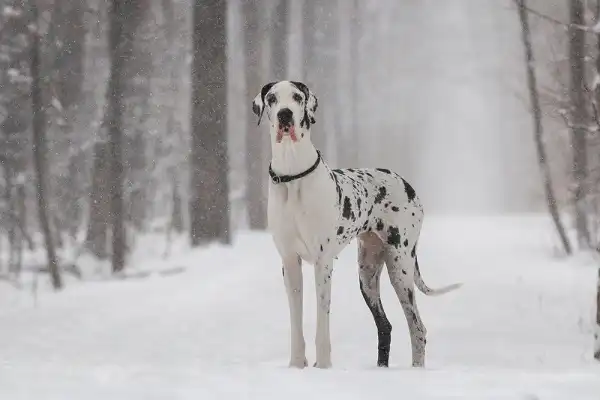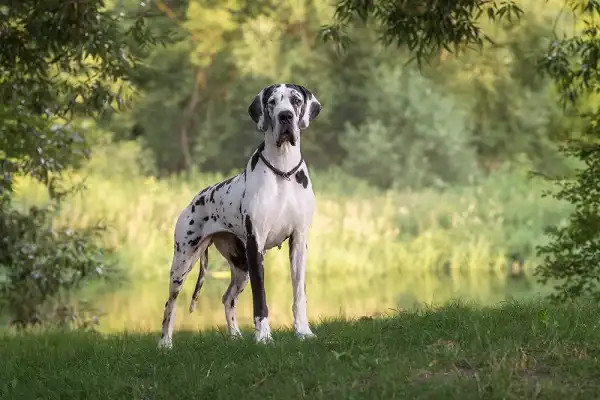Do you love big dogs? Great Danes are one of the biggest breeds, and they make wonderful companions. They’re gentle giants with a heart of gold, and they’re known for being loyal, friendly, and loving. If you’re thinking about adding a Great Dane to your family, read on to learn more about this amazing breed.

Great Dane Description
The Great Dane is a strong, large-sized breed of dog that originated in Germany. They are often referred to as the “Apollo of Dogs” due to their regal bearing and handsome appearance. While they can be intimidating due to their size, they are generally quite gentle and good-natured. They have slender, muscular bodies and long legs, with broad chests and deep rib cages. The muzzle is slightly pointed, and the ears are set high on the head. The coat of the Great Dane is short and smooth, usually consisting of shades of fawn, brindle, black or blue.
Great Dane Habitat
Great Danes are best suited to warmer climates and can be found in many parts of the world. They require an ample amount of space to stay active, healthy, and happy so they need a large backyard or outdoor area with plenty of room to roam. While they do not have a preference for any particular terrain, they will generally prefer environments that have plenty of plants, trees, and other natural features which provide shade during hot summer days. Great Danes are quite adaptable, however, so as long as their basic needs are met they can thrive in almost any living space. Great Danes also require regular exercise in order to stay healthy and prevent boredom. As such, they should be given at least one hour of exercise each day including walks and playtime in a securely fenced yard or another enclosed area. This breed is relatively low-maintenance when it comes to grooming; regular brushings will help keep their coats looking healthy and make sure that your furniture doesn’t become too covered with fur!
Great Dane Diet
The Great Dane is a large breed of dog that requires a balanced and nutritious diet in order to stay healthy and active. Because of their size, they require more food than other breeds which means that owners should be extra mindful of the type and amount of food given to their pets. A healthy diet for a Great Dane should consist mainly of high-quality proteins, fats, carbohydrates, minerals, and vitamins. Protein can come from sources such as lean beef, chicken, fish, turkey, and eggs; while healthy fats can come from sources like poultry fat or vegetable oil. Carbohydrates are important too; they provide energy and help to keep blood sugar levels stable. Whole-grain cereals such as oats are good sources of carbohydrates; while vegetables like green beans or carrots make great snacks. Additionally, it’s important to include vitamins and minerals like vitamin E, calcium, and phosphorus which all play an important role in a dog’s overall health. In order to maintain a healthy weight for your Great Dane, regular exercise is essential – at least one hour per day – as well as avoiding overfeeding them with treats or human foods that are high in calories or fat content. It’s also important to monitor their water intake – dehydration can occur quickly in this breed due to its size – so fresh water should always be available at all times during hot weather months. Lastly, regular visits to the vet will help ensure your pet remains in tip-top condition throughout its life!

Great Dane Size
The Great Dane is a giant breed of dog that can reach an impressive height and weight. Generally, males stand between 30 to 32 inches tall at the shoulders and weigh up to 175 pounds, while females usually reach 28 to 31 inches tall and weigh around 140 pounds. Despite their large size, these dogs are surprisingly agile and athletic; they have a good range of motion in their legs, allowing them to keep up with even the most energetic owner! Despite their intimidating size, Great Danes tend to be quite gentle and affectionate when it comes to interacting with humans and other animals – although caution should be taken when introducing them to smaller animals due to the possibility of accidental injury. They are also known for being sensitive dogs who respond well to positive reinforcement training methods such as clicker training or reward-based training programs.
Great Dane Lifespan
The lifespan of a Great Dane can vary greatly depending on a number of factors such as diet, exercise, health, and genetics. Generally speaking, these giant breed dogs tend to have a life expectancy ranging from 6-8 years, although some individuals may live longer with proper care and attention. In addition to diet and exercise, socialization is also essential for the development of a healthy Great Dane. This breed does best in an environment surrounded by people or other animals; it helps them learn proper social behaviors and make sure they don’t become too aggressive or fearful when interacting with others. Finally, genetics play an important role in determining how long your Great Dane will live. Responsible breeding practices are critical here as certain genetic conditions can reduce life expectancy significantly if not properly managed beforehand. With proper care and attention throughout their life span, however, Great Danes can be wonderful companions – bringing loads of joy and affection into your home!
Great Dane Behavior
Great Danes are known for being loyal, loving, and devoted to their owners. They typically have a gentle and easygoing disposition, making them great family pets. With the right socialization and training, they should get along well with other animals as well as strangers. These giant breed dogs are highly intelligent and can be trained to do a variety of tasks; they have even been used as service dogs in the past! While they may require more exercise than smaller breeds due to their size, Great Danes also need plenty of mental stimulation to help prevent boredom and destructive behaviors. Owners should provide them with lots of interactive toys, regular walks or hikes, and plenty of opportunities for playtime with their humans. When it comes to living in an apartment or condo setting, Great Danes may not thrive due to their large size; too much confinement could potentially lead to stress-related behaviors such as excessive barking or whining. Instead, they will do best in larger homes that allow them plenty of space indoors and out so that they can move around freely without any restrictions.

Great Dane Speed
Great Danes are large and powerful dogs, typically weighing between 100 and 200 pounds. Despite their size, they can be surprisingly fast runners. The average Great Dane is capable of reaching speeds of up to 40 mph in short bursts, though some individuals may be able to reach even higher speeds with enough training and conditioning. While Great Danes are not traditionally considered a breed meant for racing or competing in agility events, they do have impressive speed when necessary. Owners should take caution when allowing their Great Danes off-leash as they can easily outrun them in a matter of seconds if they get distracted by something interesting. Their muscular build allows them to accelerate quickly and maintain strong momentum over long distances; this makes them great candidates for activities like skijoring where owners can pull their Great Dane along behind them on skis or snowshoes! They also have the potential to excel at lure coursing – an activity designed for sighthounds – as well as flyball, tracking, and more. In addition to their speed, Great Danes are also known for having great stamina; this means that they can keep running for extended periods of time without tiring out too quickly. Owners should keep this in mind when deciding how much exercise their pet needs each day; providing ample opportunities for running, playing fetch games or swimming will ensure that your dog gets all the physical activity it requires while helping to strengthen its cardiovascular system at the same time.
Great Dane Hunting
Great Danes are known for their gentle and loyal nature, but they can also be excellent hunting companions. These powerful and agile dogs have the right combination of speed, strength, and stamina to make them formidable hunters – especially when it comes to big games like deer or boar. When used as a hunting companion, Great Danes are most often trained as gun dogs; this means that they are taught to stay close to their handlers during a hunt, retrieve fallen prey, and mark downed birds and other targets. They can also be trained in scent tracking; this allows them to lead the hunter directly to their quarry instead of blindly searching for it on their own. In addition to these basic commands, some owners may choose to train their Great Danes in more specialized techniques such as pointing or flushing out prey. Pointing involves teaching the dog to take a stance when they detect a game nearby; this signals the hunter that there is something in the vicinity without scaring away potential targets. Flushing involves teaching the dog to run in circles around an area until any hidden game is made visible by its movements.

Conclusion
The Great Dane is a powerful and agile dog with an impressive combination of speed, strength, and stamina. These gentle giants can be used for any number of activities; from skijoring to lure coursing and hunting, these versatile dogs have the potential to excel at anything their owners put them up too! With proper training and socialization, Great Danes make excellent companions who are sure to bring joy and excitement into their owners’ lives. Whether it’s racing around the house or hunting in the woods, these loving pups can do it all! So if you’re looking for a loyal friend who loves adventure as much as you do, look no further than the magnificent Great Dane! They won
Frequently Asked Question


